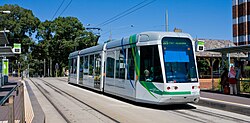C class Melbourne tram
| C-class | |
|---|---|

|
|
| Manufacturer | Alstom |
| Assembly | La Rochelle |
| Constructed | 2001/02 |
| Number in service | 36 |
| Fleet numbers | C3001-C3036 |
| Capacity | 40 (Seated) 110 (Standing) |
| Depot(s) | Kew |
| Specifications | |
| Train length | 22.98 m (75 ft 5 in) |
| Width | 2.65 m (8 ft 8 in) |
| Height | 3.36 m (11 ft 0 in) |
| Doors | 6 (three per side) |
| Articulated sections | 3 (two articulations) |
| Wheelbase | 1,850 mm (6 ft 1 in) |
| Weight | 28.6 t (28.1 long tons; 31.5 short tons) |
| Traction motors | 4 × 115 kW (154 hp) |
| Electric system(s) | 600 V DC Catenary |
| Current collection method | Pantograph |
| Track gauge | 1,435 mm (4 ft 8 1⁄2 in) standard gauge |
The (2nd) C-class trams are three-section Alstom Citadis 202 trams built in La Rochelle, France that operate on the Melbourne tram network. They were the first low-floor trams in Melbourne, being delivered in 2001/02. They are designated as "C1"-class trams, to differentate them from the C2-class trams and the original (1913) C-class Melbourne trams.
To meet a franchise commitment to introduce new trams to replace Z-class trams, 36 three-section Alstom Citadis 202 low-floor trams were purchased by Yarra Trams. They were the first low-floor trams in Melbourne, and the first tram imported for the Melbourne tram system since the 1920s.
The design was adapted by Alstom for local conditions, with the first four trams arriving at Webb Dock on 10 August 2001. Following fit-out and testing at Preston Workshops, they entered service on 12 October 2001. The last arrived on 25 June 2002 and entered service on 30 August 2002. All C1-class trams initially operated on route 109.
The Citadis trams have been criticised by the Australian Rail Tram & Bus Industry Union (RTBU), who claim they have operations problems, including injuries to the drivers relating to design. There were concerns raised in 2011 regarding the external cameras fitted to the trams. Despite Yarra Trams replacing the cameras a number of times, there were visibility issues at night and in high glare situations. These problems had been solved by July 2012.
They have also been described by the RTBU as "cheap as chips", following allegations that swaying and lateral forces at "speeds above 25 km/h" were causing driver injuries. Yarra Trams responded by stating that they were addressing the issue by offering drivers lumbar support, and that track renewal had improved ride quality, reducing sway, while Yarra Trams had previously changed to controls to avoid wrist injuries.
...
Wikipedia
